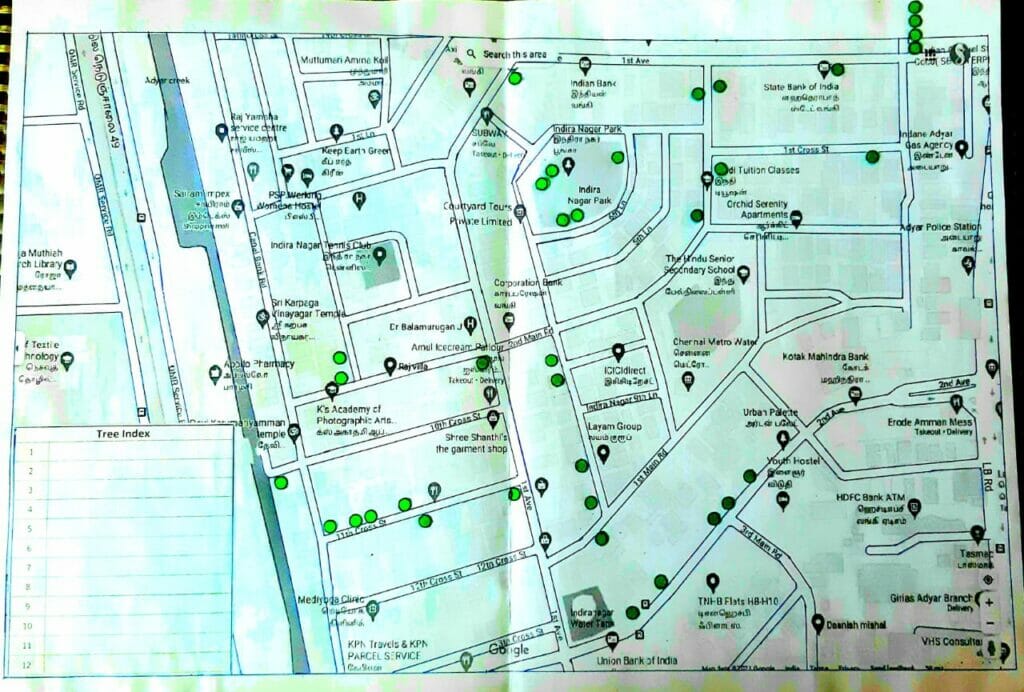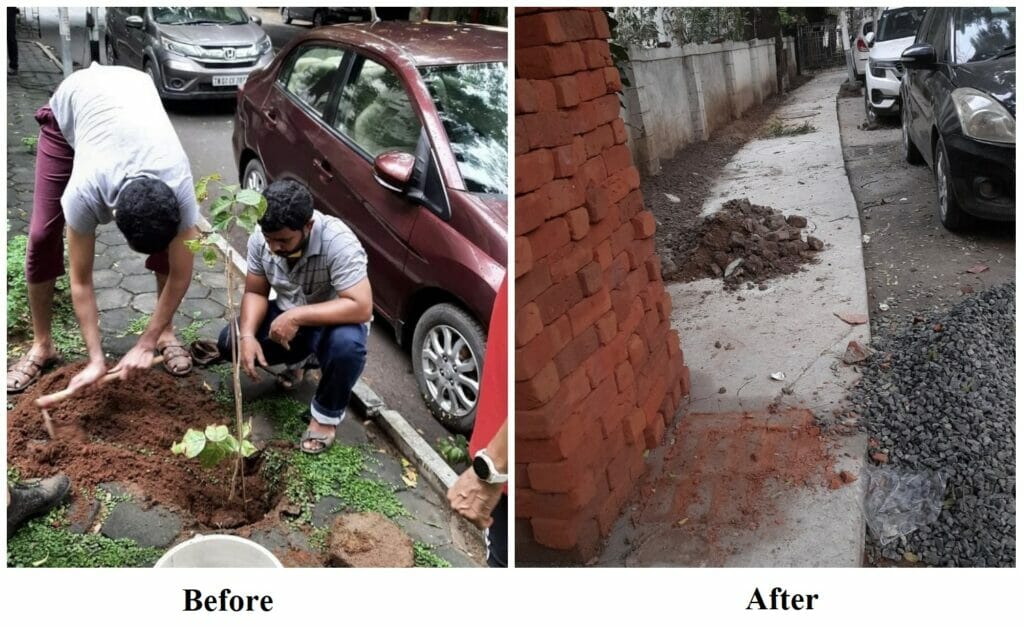Planting saplings as part of tree plantation drives in Chennai is an act that provides tremendous gratification to those who plant them. But what happens to the saplings after they are planted is a key question that we should be looking at.
How many tree plantation drives are successful in their mission? Whom does the responsibility of caring for the plants fall upon? How can tree plantation drives be made more effective?
A resident’s lament
Namachivayam C of Venkatarathinam Nagar planted 40 saplings in and around his locality ten months ago.
“I grew up seeing many trees disappear in my area in the past 30 years and wanted to see the locality flourish again with greenery,” he says.
With this intention, he, along with TD Babu, Trustee of Nizhal, went around the streets and found prospective locations to plant saplings. Then, he approached the parks department officials of the Greater Chennai Corporation (GCC) and obtained permission. He then got some sponsors to buy the saplings which were selected as per expert advice. Each sapling cost him around Rs 100. He also procured tree guards at Rs 300 each. Along with the help of some local officials, he planted all 40 saplings and made a map of them.

“I used to carry around 40 bottles of water in my car every day and spend one to two hours watering the plants, repairing the tree guards as the mesh would be vandalised, repairing the damaged plants and doing other necessary maintenance works. This was my routine for close to a year,” says Namachivayam.
During his trip around the locality, he also met a lot of residents who came forward to help him.
“Many tree guards had been vandalised. Some small plants have also been uprooted and thrown away. In some cases, some people also poured acid on the small plants. It was disheartening to see those damaged plants. However, some residents and auto drivers who saw me coming every day told me they would take care of the plants near them. More than my initiative, the change in their mindsets gave me more gratification and kept me going,” he says.
His year-long effort came to an end when the plants disappeared over a short period of time. The destruction of the plants was due to the stormwater drain work carried out in the area by the GCC.
When asked how he felt about replanting those trees, he said, “I will not get involved. I have wasted enough of my personal time, money and effort without any support from the Corporation in spite of reaching out to them. I nurtured them like my own children. When I saw them disappearing in front of my eyes, I lost heart,” he says.
Read more: Tree felling in K K Nagar for SWD work leads to protests
Lack of communication on tree plantation drives in Chennai
Many residents echo the concerns of Namachivayam. A few months ago, GCC roped in the resident welfare associations (RWAs) for a greening drive.
Meera Ravikumar, a resident of Gandhi Nagar, said that the RWAs were left to source the saplings and tree guards and also find the locations for planting them. “The only part the GCC took was in granting the nod for locations and attending the inauguration. We did the planting as and when we got the sponsors,” she says.
However, when the stormwater drain work began in the area, most of the plants were removed. the residents, who took efforts to plant them, were neither notified about the plans for removal nor had a say in it.
“It is not feasible for the RWAs to get sponsors for every such drive. Once the stormwater drain works are over, the GCC should replant the saplings at their own cost, while the residents could be roped in to take care of the plants,” she says.

Meera further adds that the residents had to launch a battle with the officials and call the District Green Committee to save a big tree in front of her apartment.
“If we had to put up a fight with them to save a full-grown tree, what would it take to save these small saplings? In many places where they had cut down the trees or removed them, the officials promised to replant them or transplant the trees. We are not aware of such initiatives In our area,” she says.
While individuals can take an effort to plant as many trees as possible, local officials should intervene to take action against vandalism and give other necessary support to such volunteers, says Namachivayam.
Curiously, a section of residents is opposed to such greening drives as they see the trees as an inconvenience.
“When the trees grow, the leaves fall in front of the house. Trees also invite birds, leading to droppings on the cars. The branches also pose a threat to the glass windows. The roots spread through the walls and weaken the building. The saplings are also a nuisance to parking,” says a resident as some of the reasons for opposing the greening drives.
In areas like KK Nagar, Karpagam Gardens, Besant Nagar, Thiruvanmaiyur and Indira Nagar, the residents have also been found to have removed the saplings along with the tree guards as the plants were a hindrance to parking vehicles.
Read more: ‘We don’t want any trees in Chennai’
Why are tree plantation drives in Chennai facing a challenge?
Most people agree that planting trees is good for the environment. While some have good intentions but lack practical or scientific knowledge. Some others merely carry out the planting, with no plans for maintenance, leaving it to the rains to look after those plants.
“Many times, greening activity regresses to a fashion statement, a one-day event where people can click pictures and post on social media platforms!” says Shobha Menon, Founder and Trustee of Nizhal.
“Some people actually say that they planted 50 saplings and 20 had survived as if it is a big deal. If there is a sensitive plan starting from the right selection of species, where they are to be planted and how they are to be taken care of, then there are good chances of all 50 plants surviving. Casualties are inevitable but at least that would not occur due to our mistakes,” she says, adding that when a person plants a sapling, he or she needs to feel morally responsible to look after it as well.
Welcoming the various greening initiatives taken by the local bodies, she said, “We are delighted that the government is taking steps to increase the green cover but the lives of these young saplings need careful monitoring and nurturing. Roping in local residents as carers in these greening drives can help. However, the government should also have a monitoring mechanism in place to ensure the planted saplings are taken care of properly, for extra safety of growing saplings.”
“For instance, in a one-year project with a 100 saplings target, we have heard from some sources that even a 50 % mortality is solved by replanting the day before hand over of the project. Of course, after the completion certificate is got, how many saplings actually survive to maturity does not matter! Which is why involving local residents, NGOs and conducting third-party audits for every greening activity taken up in the city, is very crucial,” she points out.
Read more: When Chennai trees come crashing down: The gaps in care and maintenance
Mechanism for oversight
TD Babu, Trustee of Nizhal and a member of the District Green Committee, says that the purpose of the committee is to streamline and regulate the instances of tree felling in public places. Any government project that requires the removal of trees, should come up with a proposal which includes a plan of where they are going to plant the new saplings to compensate for the loss and how those plants are to be nurtured.
The committee, which constitutes of members from various government departments and non-governmental organisations, will then inspect the location. Based on their recommendations, the trees will either be retained or transplanted or approved for removal. The department concerned should compensate for the loss of ten new trees within a radius of five kilometres in the same locality.
“Many contractors of GCC involved in stormwater drain works are not aware of this procedure. Besides, the committee could act only when an issue is brought to their notice. There is also a toll-free ‘tree helpline’ number -1800-599-7634, which many among the public are not aware of,” he says, adding that the public could address their grievance through the helpline number.
According to D Sneha, Deputy Commissioner (Education) of GCC, during the course of work such as storm water drains, GCC strives to ensure no tree or young sapling is affected. Wherever possible, diversions are made. “In case of vandalism, if specific complaints are brought to our notice, action will be taken against them,” she said.
Besides, new trees are also planted in OSR lands and other vacant public lands, with the help of RWAs and other citizen groups, who also tend to them till they grow. “They are monitored by way of inspections by field officers, and also in fortnightly meetings by the Commissioner,” she adds.
The way forward
N Muthu Karthick, Team Leader at Care Earth Trust, notes that since many essential amenities like water pipes, stormwater drains and electricity cables are being made underground now, it stands as a hindrance to the plantation of trees in Chennai.
“Many residents who would like to plant trees are not aware of the water or electricity lines that run underground. Even when the residents volunteer to plant, the trees would be affected when they start growing and require to be removed at a later stage,” he says.
A well-planned city would have a gap between stormwater drains and the roads. Since only the corporation is aware of the underground infrastructural work, only they could take the initiative based on a scientific study.
“A web portal having an application form for those willing to take up the greening drives could be launched. This will help the local body to ensure that the native species of plants are selected and the right location that has no underground hindrance for the plants is selected. It will also help in maintaining the data of trees in the city,” he says.
This suggestion has been made to the GCC along with a plantation strategy prepared by the Care Earth Trust and Infrastructure Management and Advisory Services Private Limited right after the Vardah cyclone.
While greening initiatives are much needed for the city, the lack of a long-term plan by those undertaking these efforts, errors in the selection of the kind of saplings to be planted and locations and lack of support from the local government authorities have dampened the impact of tree plantation drives in Chennai.